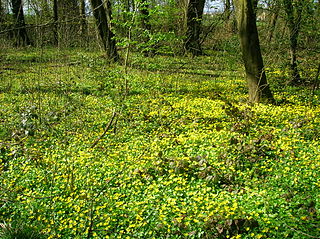
In forestry and ecology, understory, or understorey, also known as underbrush or undergrowth, includes plant life growing beneath the forest canopy without penetrating it to any great extent, but above the forest floor. Only a small percentage of light penetrates the canopy so understory vegetation is generally shade-tolerant. The understory typically consists of trees stunted through lack of light, other small trees with low light requirements, saplings, shrubs, vines and undergrowth. Small trees such as holly and dogwood are understory specialists.

Fiddleheads or fiddlehead greens are the furled fronds of a young fern, harvested for use as a vegetable.
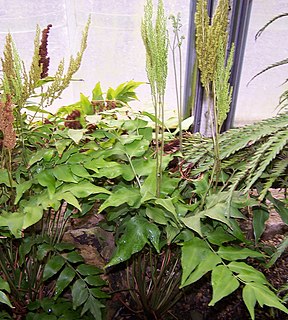
Anemia is a genus of ferns. It is the only genus in the family Anemiaceae in the Pteridophyte Phylogeny Group classification of 2016. Alternatively, the genus may be placed as the only genus in the subfamily Anemioideae of a more broadly defined family Schizaeaceae, the family placement used in Plants of the World Online as of November 2019. Its species are sometimes called flowering ferns, but this term is more commonly applied to ferns of the genus Osmunda. Fronds are dimorphic; in fertile fronds, the two lowermost pinnae are highly modified to bear the sporangia.

The Dryopteridaceae are a family of leptosporangiate ferns in the order Polypodiales. They are known colloquially as the wood ferns. In the Pteridophyte Phylogeny Group classification of 2016 (PPG I), the family is placed in the suborder Polypodiineae. Alternatively, it may be treated as the subfamily Dryopteridoideae of a very broadly defined family Polypodiaceae sensu lato.
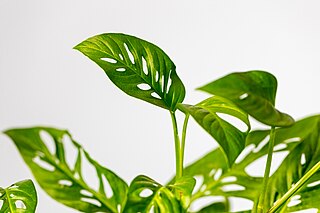
A houseplant, sometimes known as a pot plant, potted plant, or an indoor plant, is an ornamental plant that is grown indoors. As such, they are found in places like residences and offices, mainly for decorative purposes. Common houseplants are usually tropical or semi-tropical, and are often epiphytes, succulents or cacti.

The Daintree Rainforest is a region on the northeast coast of Queensland, Australia, north of Mossman and Cairns. At around 1,200 square kilometres (460 sq mi), the Daintree is a part of the largest continuous area of tropical rainforest on the Australian continent. The Daintree Rainforest is a part of the Wet Tropics of Queensland Rainforest, that spans across the Cairns Region. The Wet Tropics Rainforest is the oldest continually surviving tropical rainforest in the world. Along the coastline north of the Daintree River, tropical forest grows right down to the edge of the sea.
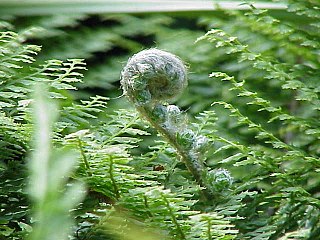
Polystichum is a genus of ferns in the family Dryopteridaceae, subfamily Dryopteridoideae, according to the Pteridophyte Phylogeny Group classification of 2016. The genus has about 500 species and has a cosmopolitan distribution. The highest diversity is in eastern Asia, with about 208 species in China alone; the region from Mexico to Brazil has at least 100 additional species; Africa, North America, and Europe have much lower diversity. Polystichum species are terrestrial or rock-dwelling ferns of warm-temperate and montane-tropical regions. They are often found in disturbed habitats such as road cuts, talus slopes, and stream banks.

Azolla filiculoides is a species of Azolla, native to warm temperate and tropical regions of the Americas which was introduced to Europe, North and sub-Saharan Africa, China, Japan, New Zealand, Australia, the Caribbean and Hawaii.

The Monserrate Palace is a palatial villa located near Sintra, the traditional summer resort of the Portuguese court in the foothills overlooking the Atlantic Ocean north of the capital, Lisbon.
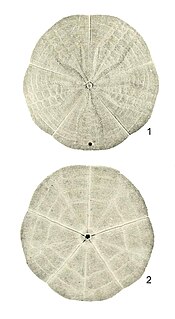
Arachnoides is a genus of sea urchin within the family Clypeasteridae, found in the Indo-Pacific oceans. The base is flat and the upper surface is convex.
Arachniodes squamulosa is a species of fern in the family Dryopteridaceae. It is endemic to Ecuador. Its natural habitats are subtropical or tropical moist lowland forests and subtropical or tropical moist montane forests. It is threatened by habitat loss.

Arachniodes is a fern genus in the family Dryopteridaceae, subfamily Dryopteridoideae, in the Pteridophyte Phylogeny Group classification of 2016. A number of species in this genus are known as "holly ferns".
Arachniodes tsiangiana is a species of fern in the family Dryopteridaceae. It is endemic to China. Its natural habitat is subtropical or tropical moist lowland forests. It is threatened by habitat loss.

Cyrtomium falcatum is a species of fern, commonly known as house holly-fern and Japanese holly fern, in the wood fern family Dryopteridaceae. It is native to eastern Asia.

Polystichum lonchitis is a species of fern known by the common name northern hollyfern, or simply holly-fern. It is native to much of the Northern Hemisphere from Eurasia to Alaska to Greenland and south into mountainous central North America. It has stiff, glossy green, erect fronds and grows in moist, shady, rocky mountain habitats.

Ferns N Petals (FNP) is an Indian gifting company founded by Vikaas Gutgutia in 1994. FNP provides flowers, cakes, plants and other gift items to customers. FNP delivers across 450+ cities & towns across India and 120+ countries worldwide
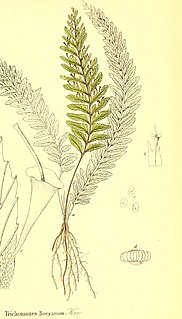
Cephalomanes atrovirens is a species of fern in the family Hymenophyllaceae. The genus Cephalomanes is accepted in the Pteridophyte Phylogeny Group classification of 2016, but not by some other sources. As of October 2019, Plants of the World Online sank the genus into a broadly defined Trichomanes, while treating the subtaxa of this species as the separate species Trichomanes acrosorum, Trichomanes atrovirens, Trichomanes boryanum and Trichomanes kingii.

Arachniodes aristata is a species of fern in the family Dryopteridaceae. It is a glossy fern with fronds up to 1 m long. The type specimen was collected by George Forster at an unknown island in the Pacific Ocean, when travelling on the second voyage of James Cook. This plant was first formally named Polypodium aristatum in 1786 in the Florulae Insularum Australium Prodromus, published by his father Johann Reinhold Forster. The specific epithet "aristata" derives from Latin, meaning "bearing a bristle".

Ardisia crispa, the Japanese holly, is a species of flowering plant in the family Primulaceae. It is found in the eastern Himalayas, Assam, southern China, Indochina, Taiwan, Korea, the Ryukyu Islands, and Japan, and has been introduced to Queensland, Australia, and the Windward Islands in the Caribbean. An evergreen perennial shrub reaching at most 1.5 m (5 ft), it is often sold as an ornamental for its dark green leaves and long‑lasting red berries, much like Ardisia crenata, the Christmas berry or coralberry.

















